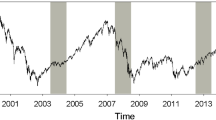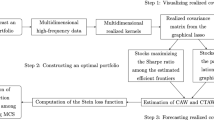Abstract
We propose a new method for estimating the covariance matrix of a multivariate time series of financial returns. The method is based on estimating sample covariances from overlapping windows of observations which are then appropriately weighted to obtain the final covariance estimate. We extend the idea of (model) covariance averaging offered in the covariance shrinkage approach by means of greater ease of use, flexibility and robustness in averaging information over different data segments. The suggested approach does not suffer from the curse of dimensionality and can be used without problems of either approximation or any demand for numerical optimization.
Similar content being viewed by others
Notes
Note that the \(\displaystyle \widehat{\alpha }_{1}\) estimate of the smoothing parameter is, by construction, less than 1 and positive.
This is the average cost that one of the major online brokerage houses charges the individual investor.
We perform a standard estimation and test for zero mean differences using a GMM-based approach and standard errors. Details of the calculations and many other statistics beyond those presented are available on request.
The maximum drawdown is defined as the largest peak-to-trough drop in the portfolio value during the underlying evaluation period.
Counting the number of times that a table entry is greater than 50 %.
References
Bajeux-Besnainou, I., Bandara, W., Bura, E.: A Krylov subspace approach to large portfolio optimization. J. Econ. Dynam. Control 36(11), 1688–1699 (2012)
Bauwens, L., Laurent, S., Rombouts, J.V.K.: Multivariate GARCH models: a survey. J. Appl. Econ. 21(1), 79–109 (2006)
Bhattacharya, P., Thomakos, D.D.: Improving forecasting performance by window and model averaging. Quantf Research, Working Paper Series, Forthcoming, 2011
Chan, L.K.C., Karceski, J., Lakonishok, J.: On portfolio optimization: forecasting covariances and choosing the risk model. Rev. Financial Stud. 12(5), 937–974 (1999)
Clark, T.E., McCracken, M.W.: Improving forecast accuracy by combining recursive and rolling forecasts. Int. Econ. Rev. 50(2), 363–395 (2009)
DeMiguel, V., Garlappi, L., Uppal, R.: Optimal versus naive diversification: how inefficient is the 1/N portfolio strategy? Rev. Financ. Stud. 22(5), 1915–1953 (2007)
DeMiguel, V., Garlappi, L., Nogales, F.J., Uppal, R.: A generalized approach to portfolio optimization: improving performance by constraining portfolio norms. Manag. Sci. 55(5), 798–812 (2009)
Engle, R.: Dynamic conditional correlation: a simple class of multivariate generalized autoregressive conditional heteroskedasticity models. J. Bus. Econ. Stat. 20(3), 339–350 (2002)
Fan, J., Fan, Y., Lv, J.: High dimensional covariance matrix estimation using a factor model. J. Econ. 147, 186–197 (2008)
Huo, L., Tae-Hwan, K., Kim, Y.: Robust estimation of covariance and its application to portfolio optimization. Finance Res. Lett. 9(3), 121–134 (2012)
Jagannathan, R., Ma, T.: Risk reduction in large portfolios: why imposing the wrong constraints helps. J. Finance 50(4), 1651–1684 (2003)
Khan, R., Zhou, G.: Optimal portfolio choice with parameter uncertainty. J. Financial Quant. Anal. 42, 621–656 (2007)
Kourtis, A., Dotsis, G., Markellos, R.N.: Parameter uncertainty in portfolio selection: shrinking the inverse covariance matrix. J. Bank. Finance 36(9), 2522–2531 (2012)
Kwan, C.C.Y.: Estimation error in the average correlation of security returns and shrinkage estimation of covariance and correlation matrices. Finance Res. Lett. 5, 236–244 (2008)
Ledoit, O., Santa-Clara, P., Wolf, M.: Flexible multivariate GARCH modeling with an application to international stock markets. Rev. Econ. Stat. 85, 735–747 (2003)
Ledoit, O., Wolf, M.: Improved estimation for the covariance matrix of stock returns with an application to portfolio selection. J. Empir. Finance 10(5), 603–621 (2003)
Ledoit, O., Wolf, M.: Honey, I shrunk the sample covariance matrix. J. Portf. Manag. 31(1), 110–119 (2004)
Markowitz, H.: Portfolio selection. J. Finance 7, 77–91 (1952)
Martellini, L., Ziemann, V.: Improved estimates of higher-order comoments and implications for portfolio selection. Rev. Financial Stud. 23–4, 1467–1502 (2010)
Patton, A.J., Sheppard, K.: Evaluating volatility and correlation forecasts. In: Handbook of Financial Time Series Analysis, pp. 801–838. Springer, Berlin (2009).
Pelletier, D.: Regime switching for dynamic correlations. J. Econom. 131(1–2), 445–473 (2006)
Pesaran, M.H., Schuermann, T., Smith, L.V.: Forecasting economic and financial variables with global VARs. Int. J. Forecast. 25(4), 642–675 (2009)
Rossi, B., Inoue, A.: Out-of-sample forecast tests robust to the choice of window size. J. Bus. Econ. Stat. 30(3), 432–453 (2012)
Silvennoinen, A., Terasvirta, T.: Modeling multivariate autoregressive conditional heteroskedasticity with the double smooth transition conditional correlation GARCH model. J. Financ. Econ. 7(4), 373–411 (2009)
Wang, Z.: A shrinkage approach to model uncertainty and asset allocation. Rev. Financ. Stud. 18(2), 673–705 (2005)
Acknowledgments
The authors are very grateful for helpful comments from the editor and an anonymous referee. Any remaining errors are our responsibility.
Author information
Authors and Affiliations
Corresponding author
Rights and permissions
About this article
Cite this article
Papailias, F., Thomakos, D.D. Covariance averaging for improved estimation and portfolio allocation. Financ Mark Portf Manag 29, 31–59 (2015). https://doi.org/10.1007/s11408-014-0242-0
Published:
Issue Date:
DOI: https://doi.org/10.1007/s11408-014-0242-0




